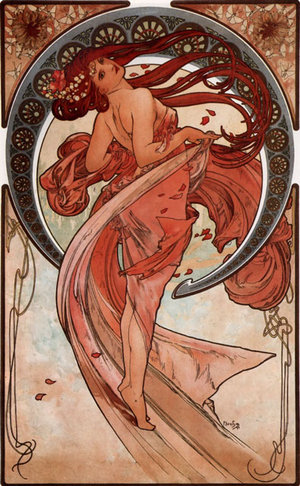Alfons Mucha
|
|
Alfons Mucha Template:Audio (July 24, 1860 - July 14, 1939) was a Czech painter and decorative artist. His name is also sometimes rendered in English as Alphonse Mucha. Mucha was perhaps the most defining artist of the Art Nouveau style.
Alfons Maria Mucha was born in the town of Ivančice, Moravia (now in the Czech Republic, then part of the Austrian Empire).
His singing abilities allowed him to continue his education through high-school in the Moravian capital of Brno, however drawing was first love since childhood. He worked at decorative painting jobs in Moravia, mostly painting theatrical scenery, then in 1879 moved to Vienna to work for a leading Viennese theatrical design company, while informally furthering his artistic education. When a fire destroyed his employer's business in 1881 he returned to Moravia, doing freelance decorative and portrait painting. Count Karl Khuen of Mikulov hired Mucha to decorate Hrušovany Emmahof Castle with murals, and was impressed enough that he agreed to sponsor Mucha's formal training at the Munich Academy of Fine Arts.
Mucha moved to Paris in 1887, and continued his studies at Académie Julian and Academie Colarossi while also producing magazine and advertising illustrations.
In 1894, he produced the artwork for a lithographed poster advertising Sarah Bernhardt at the Theatre de la Renaissance. Mucha's lush stylized poster art won him fame and numerous commissions.
Mucha produced a flurry of paintings, posters, advertisements, and book illustrations, as well as designs for jewellery, carpets, wallpaper, and theatre sets in what came to be known as the Art Nouveau style. Mucha's works frequently featured beautiful healthy young women in flowing vaguely Neoclassical looking robes, often surrounded by lush flowers which sometimes formed haloes behind the women's heads. His style was often imitated.
Mucha visited the USA from 1906 to 1910, then returned to the Czech lands and settled in Prague, where he decorated the Theater of Fine Arts and other landmarks of the city.
When Czechoslovakia won its independence after World War I, Mucha designed the new postage stamps, banknotes, and other government documents for the new nation.
He spent years working on what he considered his masterpiece, The Slav Epic, a series of huge paintings depicting the history of the Slavic peoples, unveiled in Prague in 1928.
He died in Prague July 14, 1939 and was interred there in the Vyšehrad cemetery.
By the time of his death, Mucha's style was considered outdated and old fashioned, but interest in his art revived first in the 1960s, and continues to experience periodic revivals of interest and influence on contemporary illustrators. Much of the interest in Mucha's work can be attributed to his son, author Jiří Mucha, who wrote extensively about his father and devoted much of his life to bringing attention to his father's art.
External links
- Biography on Mucha Museum website (http://www.mucha.cz/index.phtml?S=biog&Lang=EN)
- Website of Mucha Museum in Prague (http://www.mucha.cz/index.phtml?S=home&Lang=EN)
- Mark Harden's Artchive (http://artchive.com/artchive/M/mucha.html) webpage on Alfons Muchabg:Алфонс Муха
da:Alfons Mucha de:Alfons Maria Mucha eo:Alfons MUCHA fr:Alfons Mucha it:Alfons Mucha ja:アルフォンス・ミュシャ nl:Alphonse Mucha no:Alfons Mucha pl:Alfons Mucha fi:Alfons Mucha sv:Alfons Mucha ru:Муха, Альфонс Мариа

